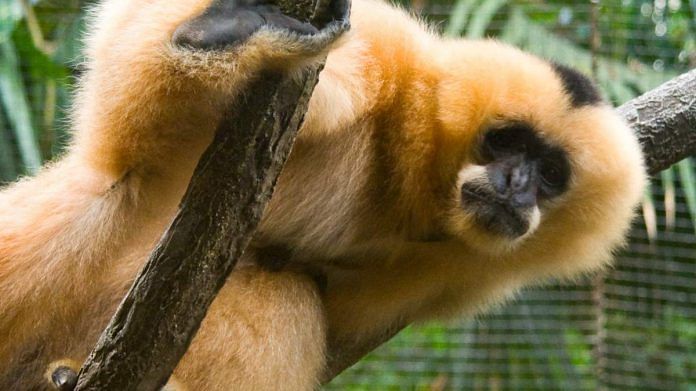A critically-endangered gibbon species in China has been thrown a lifeline – literally – with the creation of a simple rope bridge across a 15-metre gap in the forest.
Conservationists created the wildlife crossing – known as an artificial canopy bridge – on China’s Hainan Island after it was hit, in 2014, by Typhoon Rammasun, the strongest typhoon to make landfall in mainland China since 1949. The storm caused landslides that carved gaps of up to 30 metres wide through the forest, destroying the highway of treetops that the gibbons swing through.
The Hainan gibbon is the rarest primate species on Earth and is endemic to China’s Hainan Island. Only around 30 individuals remain, all living in Hainan Bawangling National Nature Reserve.
Bridging the gap
To make the crossing, mountaineering-grade ropes were tied to sturdy trees and a camera was installed to monitor its usage, the researchers explain in their study, published in Scientific Reports.
The gibbons started using the bridge about 176 days after it was installed, and increased their use of it over time. All members of the gibbon group crossed the 15.8m rope bridge, except for one adult male, according to the report’s authors.
“While restoring natural forest corridors should be a priority conservation intervention,” they say, “artificial canopy bridges may be a useful short-term solution.”
Also read: ‘Worst of the worst of the worst’ — Why 2020 has seen so many wildfires
Crossings save money and lives
Canopy bridges are increasingly being used to create wildlife crossings in places such as Latin America, Asia, Australia and India.
Crossings built under or over highways can also protect animals from vehicle collisions. In the United States, a report by the Federal Highway Administration found the survival of 21 threatened and endangered species – including American crocodiles, Florida panthers and bighorn sheep in California – was at risk from road mortalities.
Studies of wildlife deaths on highways, including jaguars in Mexico, have shown that wildlife crossings save money, as well as both human and animal lives.
Biodiversity loss
Human activity – including logging, the conversion of forests into agricultural areas and suburbanization – has been identified as the biggest contributor to the decline and loss of habitat and species diversity worldwide.
Humans have caused the loss of 83% of all wild mammals and half of all plants, research published in the Proceedings of the National Academy of Sciences found.
Habitat fragmentation is one of the major causes of biodiversity loss, the Hainan gibbon researchers warn in their study. The impact is particularly detrimental to arboreal – tree-dwelling – wildlife, because forest gaps affect how the animals disperse, forage, conserve energy and breed. It can also increase vulnerability to predators, disease, parasites and accidental fatalities such as roadkill and electrocution. Isolated populations are then at greater risk of being wiped out.
Why biodiversity matters
Despite numerous government pledges, biodiversity loss is accelerating in all regions of the world, according to the United Nations Environment Programme.
This is critical because biodiversity underpins life on Earth, including the availability of fresh water, food and fuel sources. For example, millions of species work together to provide humans with a large array of fruits, vegetables and animal products. Plants are essential in the creation of medicines. Livelihoods also depend on biodiversity. Globally, three out of four jobs are dependent on water, while the agricultural sector employs over 60% of the world’s working poor.
“An estimated 795 million people suffer from hunger and 1.2 billion live in water-stressed areas,” the UN Environment Programme says. “At the same time, biodiversity loss and ecosystem degradation are expected to continue, or even accelerate. By 2030, the world will require 40% more water, 50% more food, 40% more energy and 40% more timber and fibre. The only way we can meet these demands is by managing our ecosystems smartly and sustainably.”
Victoria Masterson is Senior Writer, Formative Content
This article was originally published in the World Economic Forum.
Also read: Scientists find out how plants pass on defects to offspring



